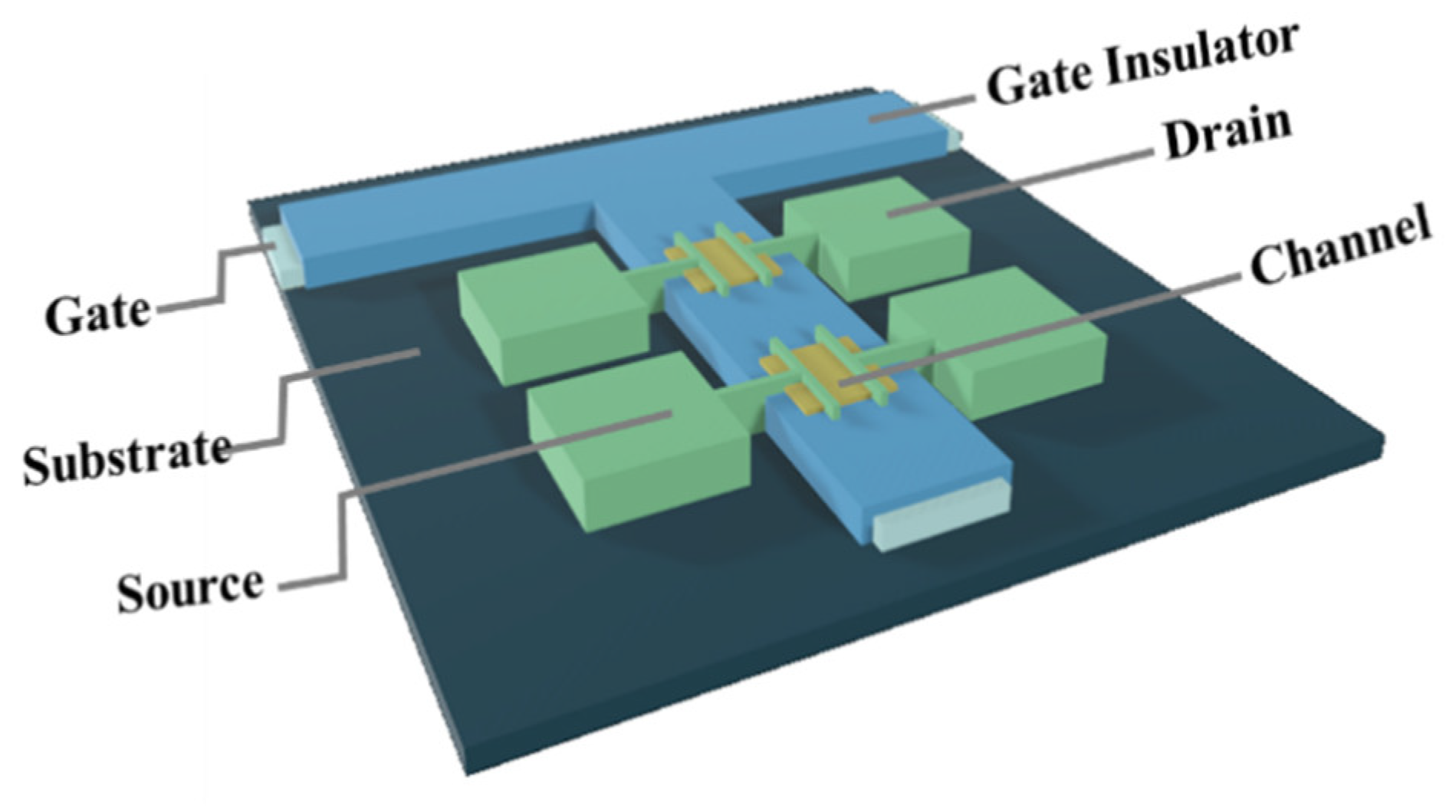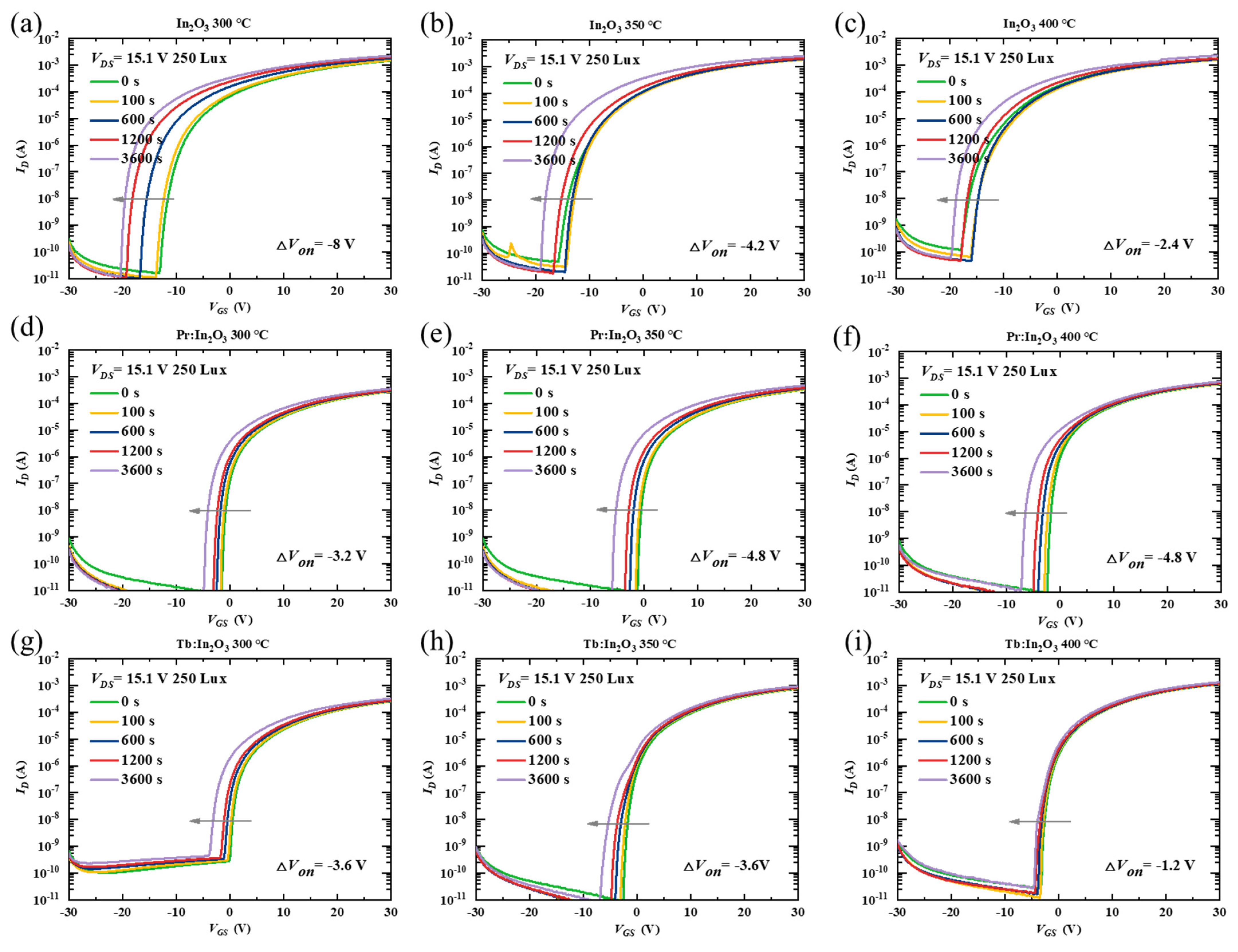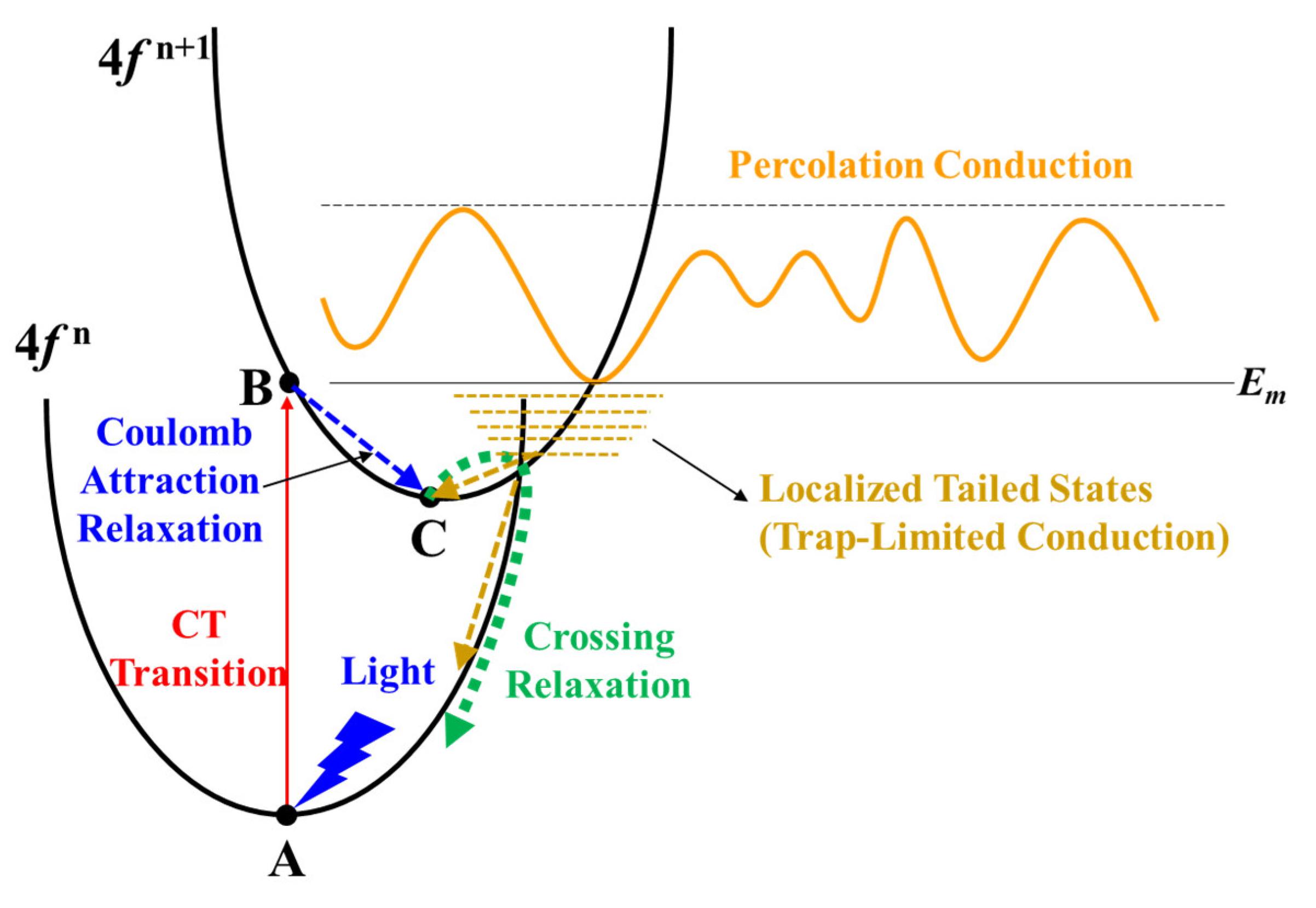The Mechanism of the Photostability Enhancement of Thin-Film Transistors Based on Solution-Processed Oxide Semiconductors Doped with Tetravalent Lanthanides
Abstract
:1. Introduction
2. Experimental Section
2.1. Precursor Solutions
2.2. Device Fabrication
2.3. Characterization of Films and Devices
3. Results and Discussion
3.1. TFT Characteristics
3.2. Film Structures
3.3. NBIS Instabilities
3.4. Oxygen Vacancies
3.5. Temperature-Dependent Performances
3.6. Mechanisms of NBIS Instability
3.7. Effect of the CT Transition of Pr4+/Tb4+ on the Photo Stability
3.8. Formatting of Mathematical Components
4. Conclusions
Supplementary Materials
Author Contributions
Funding
Data Availability Statement
Conflicts of Interest
References
- Nomura, K.; Ohta, H.; Takagi, A.; Kamiya, T.; Hirano, M.; Hosono, H. Room-Temperature Fabrication of Transparent Flexible Thin-Film Transistors Using Amorphous Oxide Semiconductors. Nature 2004, 432, 488–492. [Google Scholar] [CrossRef] [PubMed]
- Asal, K.; Henrique, L.G.; Pedro, B.; Jorge, M.; Ana, R.; Joana, V.P.; Rodrigo, M.; Elvira, F. Improving positive and negative bias illumination stress stability in parylene passivated IGZO transistors. Appl. Phys. Lett. 2016, 109, 051606. [Google Scholar]
- Yao, J.K.; Ye, F.; Fan, P. Ultraviolet laser damage mechanism of amorphous InGaZnO4 thin films. Opt. Mater. Express 2019, 9, 2545–2552. [Google Scholar] [CrossRef]
- Dekkers, H.F.W.; Van Setten, M.J.; Belmonte, A.; Chasin, A.V.; Subhechha, S.; Rassoul, N.; Glushkova, A.V.; Delhougne, R.; Kar, G.S. Deposition, Characterization, and Performance of Spinel InGaZnO4. ACS Appl. Electron. Mater. 2022, 4, 1238–1249. [Google Scholar] [CrossRef]
- Cha, S.K.; Im, S.; Kim, Y.S.; Baeck, J.; Noh, J.; Park, K.S.; Kim, J.J.; Yoon, S.Y. Density-Dependent Microstructures and Electromechanical Properties of Amorphous InGaZnO4 Semiconductors: An Ab Initio Study. ACS Appl. Electron. Mater. 2022, 4, 2545–2551. [Google Scholar] [CrossRef]
- Shi, J.; Zhang, J.; Yang, L.; Qu, M.; Qi, D.; Zhang, K.H.L. Wide Bandgap Oxide Semiconductors: From Materials Physics to Optoelectronic Devices. Adv. Mater. 2021, 33, 30. [Google Scholar] [CrossRef]
- Ting-Kuo, C.; Chin-Wei, L.; Shihchang, C. LTPO TFT Technology for AMOLEDs. SID Symp. Dig. Tech. Pap. 2019, 50, 545–548. [Google Scholar]
- Jung, H.Y.; Kang, Y.; Hwang, A.Y.; Lee, C.K.; Han, S.; Kim, D.H.; Bae, J.U.; Shin, W.S.; Jeong, J.K. Origin of the Improved Mobility and Photo-Bias Stability in a Double-Channel Metal Oxide Transistor. Sci. Rep. 2014, 4, 8. [Google Scholar] [CrossRef] [Green Version]
- Xu, H.; Xu, M.; Li, M.; Chen, Z.; Zou, J.; Wu, W.; Qiao, X.; Tao, H.; Wang, L.; Ning, H.; et al. Trap-Assisted Enhanced Bias Illumination Stability of Oxide Thin Film Transistor by Praseodymium Doping. ACS Appl. Mater. Interfaces 2019, 11, 5232–5239. [Google Scholar] [CrossRef]
- Li, J.; Fu, Y.Z.; Huang, C.X.; Zhang, J.H.; Jiang, X.Y.; Zhang, Z.L. Nitrogen Anion Doping as a Strategy to Suppress Negative Gate-Bias Illumination Instability of ZnSnO Thin Film Transistor. Appl. Phys. Lett. 2016, 108, 5. [Google Scholar] [CrossRef]
- Kim, J.; Bang, J.; Nakamura, N.; Hosono, H. Ultra-Wide Bandgap Amorphous Oxide Semiconductors for NBIS-Free Thin-Film Transistors. APL Mater. 2019, 7, 4. [Google Scholar] [CrossRef] [Green Version]
- Shiah, Y.S.; Sim, K.; Shi, Y.H.; Abet, K.; Ueda, S.; Sasase, M.; Kim, J.; Hosono, H. Mobility-Stability Trade-off in Oxide Thin-Film Transistors. Nat. Electron. 2021, 4, 800–807. [Google Scholar] [CrossRef]
- He, P.; Lan, L.; Deng, C.; Wu, Y.; Lin, Y.; Chen, S.; Ding, C.; Xu, M.; Peng, J. The Effect of Charge Transfer Transition on the Photostability of Lanthanide-Doped Indium Oxide Thin-Film Transistors. Commun. Mater. 2021, 2, 1–10. [Google Scholar] [CrossRef]
- Lan, L.; Zhao, M.; Xiong, N.; Xiao, P.; Shi, W.; Xu, M.; Peng, J. Low-Voltage High-Stability Indium-Zinc Oxide Thin-Film Transistor Gated by Anodized Neodymium-Doped Aluminum. IEEE Electron Device Lett. 2012, 33, 827–829. [Google Scholar] [CrossRef]
- Li, Y.; Lan, L.; Sun, S.; Lin, Z.; Gao, P.; Song, W.; Song, E.; Zhang, P.; Peng, J. All Inkjet-Printed Metal-Oxide Thin-Film Transistor Array with Good Stability and Uniformity Using Surface Energy Patterns. ACS Appl. Mater. Interfaces 2017, 9, 8194–8200. [Google Scholar] [CrossRef]
- Ryu, B.; Noh, H.K.; Choi, E.A.; Chang, K.J. O-vacancy as the origin of negative bias illumination stress instability in amorphous In-Ga-Zn-O thin film transistors. Appl. Phys. Lett. 2010, 97, 022108. [Google Scholar] [CrossRef] [Green Version]
- Lan, L.; Li, X.; Ding, C.; Chen, S.; Su, H.; Huang, B.; Chen, B.; Zhou, H.; Peng, J. The Effect of the Charge Transfer Transition of the Tetravalent Terbium on the Photostability of Oxide Thin-film Transistors. Adv. Electron. Mater. 2022, 8, 2200187. [Google Scholar] [CrossRef]
- Zhang, H.; Liang, L.; Wang, X.; Wu, Z.; Cao, H. Praseodymium-Doped In-Sn-Zn-O TFTs With Effective Improvement of Negative-Bias Illumination Stress Stability. IEEE Trans. Electron Devices 2022, 69, 152–155. [Google Scholar] [CrossRef]
- Nomura, K.; Kamiya, T.; Ohta, H.; Ueda, K.; Hirano, M.; Hosono, H. Carrier Transport in Transparent Oxide Semiconductor with Intrinsic Structural Randomness Probed Using Single-Crystalline InGaO3(ZnO)(5) Films. Appl. Phys. Lett. 2004, 85, 1993–1995. [Google Scholar] [CrossRef]
- Lee, S.; Ghaffarzadeh, K.; Nathan, A.; Robertson, J.; Jeon, S.; Kim, C.; Song, I.H.; Chung, U.I. Trap-Limited and Percolation Conduction Mechanisms in Amorphous Oxide Semiconductor Thin Film Transistors. Appl. Phys. Lett. 2011, 98, 3. [Google Scholar] [CrossRef]
- Chatratin, I.; Sabino, F.P.; Reunchan, P.; Limpijumnong, S.; Varley, J.B.; Van de Walle, C.G.; Janotti, A. Role of Point Defects in the Electrical and Optical Properties of In2O3. Phys. Rev. Mater. 2019, 3, 9. [Google Scholar] [CrossRef] [Green Version]
- Medvedeva, J.E.; Zhuravlev, I.A.; Burris, C.; Buchholz, D.B.; Grayson, M.; Chang, R.P.H. Origin of High Carrier Concentration in Amorphous Wide-bandgap Oxides: Role of Disorder in Defect Formation and Electron Localization in In2O3-x. J. Appl. Phys. 2020, 127, 24. [Google Scholar] [CrossRef]
- Janotti, A.; Walle, C.G.V.D. Oxygen Vacancies in ZnO. Appl. Phys. Lett. 2005, 87, 125210. [Google Scholar] [CrossRef]
- Lany, S.; Zunger, A. Anion Vcancies as a Source of Persistent Photoconductivity in II-VI and Chalcopyrite Semiconductors. Phys. Rev. B 2005, 72, 13. [Google Scholar] [CrossRef] [Green Version]
- Janotti, A.; Walle, C. Native Point Defects in ZnO. Phys. Rev. B 2007, 76, 165202. [Google Scholar] [CrossRef]
- Jeong, J.K. Photo-Bias Instability of Metal Oxide Thin Film Transistors for Advanced Active Matrix Displays. J. Mater. Res. 2013, 28, 2071–2084. [Google Scholar] [CrossRef]
- Long, T.; Dai, X.; Lan, L.; Deng, C.; Chen, Z.; He, C.; Liu, L.; Yang, X.; Peng, J. High-Performance CdScInO Thin-Film Transistors and Their Stability Improvement under Negative Bias (Illumination) Temperature Stress. J. Mater. Chem. C 2019, 7, 13960–13965. [Google Scholar] [CrossRef]
- Lee, D.H.; Kawamura, K.; Nomura, K.; Kamiya, T.; Hosono, H. Large Photoresponse in Amorphous In-Ga-Zn-O and Origin of Reversible and Slow Decay. Electrochem. Solid State Lett. 2010, 13, II324–II327. [Google Scholar] [CrossRef]
- Mondal, S.; Raychaudhuri, A.K. Observation of a Large Gate-controlled Persistent Photoconduction in Single Crystal ZnO at Room Temperature. Appl. Phys. Lett. 2011, 98, 3. [Google Scholar] [CrossRef]
- Flewitt, A.J.; Powell, M.J. A Thermalization Energy Analysis of the Threshold Voltage Shift in Amorphous Indium Gallium Zinc Oxide Thin Film Transistors under Simultaneous Negative Gate Bias and Illumination. J. Appl. Phys. 2014, 115, 7. [Google Scholar] [CrossRef] [Green Version]
- Hobart, D.E.; Samhoun, K.; Young, J.P.; Norvell, V.E.; Peterson, J.R. Stabilization of Praseodymium(IV) and Terbium(IV) in Aqueous Carbonate Solution. Chem. Inf. 1980, 11, 321–328. [Google Scholar] [CrossRef]
- Blasse, G. Luminescence of Inorganic Solids: From Isolated Centres to Concentrated Systems. Prog. Solid State Chem. (UK) 1988, 18, 79–191. [Google Scholar] [CrossRef]
- Gorai, T.; Schmitt, W.; Gunnlaugsson, T. Highlights of the Development and Application of Luminescent Lanthanide Based Coordination Polymers, MOFs and Functional Nanomaterials. Dalton Trans. 2021, 50, 770–784. [Google Scholar] [CrossRef] [PubMed]
- Kim, J.S.; Na, C.W.; Kwak, C.H.; Li, H.Y.; Yoon, J.W.; Kim, J.H.; Jeong, S.Y.; Lee, J.H. Humidity-Independent Gas Sensors Using Pr-Doped In2O3 Macroporous Spheres: Role of Cyclic Pr3+/Pr4+ Redox Reactions in Suppression of Water-Poisoning Effect. ACS Appl. Mater. Interfaces 2019, 11, 25322–25329. [Google Scholar] [CrossRef]
- Gu, S.; Li, W.; Bian, Y.; Wang, F.; Li, H.; Liu, X. Highly-Visible-Light Photocatalytic Performance Derived from a Lanthanide Self-Redox Cycle in Ln2O3/BiVO4 (Ln: Sm, Eu, Tb) Redox Heterojunction. J. Phys. Chem. C 2016, 120, 19242–19251. [Google Scholar] [CrossRef]
- Dorenbos, P. Systematic Behaviour in Trivalent Lanthanide Charge Transfer Energies. J. Phys.-Condes. Matter 2003, 15, 8417–8434. [Google Scholar] [CrossRef]
- Holsa, J.; Aitasalo, T.; Jungner, H.; Lastusaari, M.; Niittykoski, J.; Spano, G. Role of Defect States in Persistent Luminescence Materials. J. Alloy. Compd. 2004, 374, 56–59. [Google Scholar] [CrossRef]
- Zych, E.; Deren, P.J.; Strek, W.; Meijerink, A.; Mielcarek, W.; Domagala, K. Preparation, X-ray Analysis and Spectroscopic Investigation of Nanostructured Lu2O3: Tb. J. Alloy. Compd. 2001, 323, 8–12. [Google Scholar] [CrossRef]
- Minasian, S.G.; Batista, E.R.; Booth, C.H.; Clark, D.L.; Keith, J.M.; Kozimor, S.A.; Lukens, W.W.; Martin, R.L.; Shuh, D.K.; Stieber, S.C.E.; et al. Quantitative Evidence for Lanthanide-Oxygen Orbital Mixing in CeO2, PrO2, and TbO2. J. Am. Chem. Soc. 2017, 139, 18052–18064. [Google Scholar] [CrossRef]







| T (°C) | μ (cm2·V−1·s−1) | SS (V/dec) | Vth (V) | Ion/Ioff | ΔVon under NBIS (V) | |
|---|---|---|---|---|---|---|
| In2O3 | 300 | 16.6 | 0.27 | 5.6 × 107 | Bias dependent | |
| 350 | 24.5 | 0.55 | 2.9 × 107 | Bias dependent | ||
| 400 | 23.4 | 0.68 | 6.8 × 106 | Bias dependent | ||
| Pr:In2O3 | 300 | 5.0 | 0.11 | 1.8 | 8.4 × 109 | −3.2 |
| 350 | 6.1 | 0.14 | 1.5 | 3.0 × 107 | −4.8 | |
| 400 | 10.1 | 0.13 | 0.4 | 5.1 × 107 | −4.8 | |
| Tb:In2O3 | 300 | 4.7 | 0.12 | 2.6 | 3.7 × 109 | −3.6 |
| 350 | 13.4 | 0.17 | 1.2 | 1.8 × 108 | −3.6 | |
| 400 | 18.2 | 0.15 | 1.4 | 6.9 × 107 | −1.2 |
Publisher’s Note: MDPI stays neutral with regard to jurisdictional claims in published maps and institutional affiliations. |
© 2022 by the authors. Licensee MDPI, Basel, Switzerland. This article is an open access article distributed under the terms and conditions of the Creative Commons Attribution (CC BY) license (https://creativecommons.org/licenses/by/4.0/).
Share and Cite
Lan, L.; Ding, C.; He, P.; Su, H.; Huang, B.; Xu, J.; Zhang, S.; Peng, J. The Mechanism of the Photostability Enhancement of Thin-Film Transistors Based on Solution-Processed Oxide Semiconductors Doped with Tetravalent Lanthanides. Nanomaterials 2022, 12, 3902. https://doi.org/10.3390/nano12213902
Lan L, Ding C, He P, Su H, Huang B, Xu J, Zhang S, Peng J. The Mechanism of the Photostability Enhancement of Thin-Film Transistors Based on Solution-Processed Oxide Semiconductors Doped with Tetravalent Lanthanides. Nanomaterials. 2022; 12(21):3902. https://doi.org/10.3390/nano12213902
Chicago/Turabian StyleLan, Linfeng, Chunchun Ding, Penghui He, Huimin Su, Bo Huang, Jintao Xu, Shuguang Zhang, and Junbiao Peng. 2022. "The Mechanism of the Photostability Enhancement of Thin-Film Transistors Based on Solution-Processed Oxide Semiconductors Doped with Tetravalent Lanthanides" Nanomaterials 12, no. 21: 3902. https://doi.org/10.3390/nano12213902





